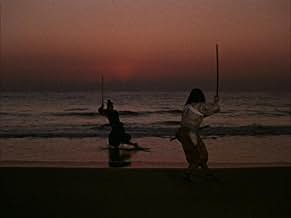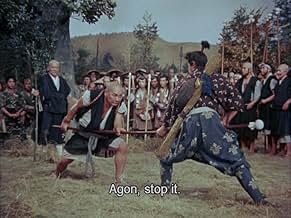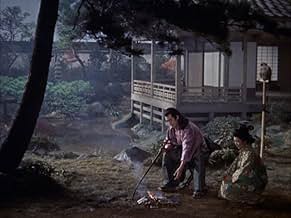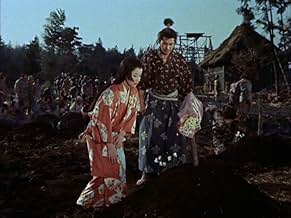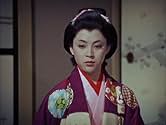O Samurai Dominante 3: Duelo na ilha Ganryu
Título original: Miyamoto Musashi kanketsu-hen: Kettô Ganryû-jima
AVALIAÇÃO DA IMDb
7,5/10
7 mil
SUA AVALIAÇÃO
Adicionar um enredo no seu idiomaMusashi Miyamoto is challenged to a duel by a confident swordsman Sasaki Kojiro. He agrees to fight him in a year's time.Musashi Miyamoto is challenged to a duel by a confident swordsman Sasaki Kojiro. He agrees to fight him in a year's time.Musashi Miyamoto is challenged to a duel by a confident swordsman Sasaki Kojiro. He agrees to fight him in a year's time.
- Direção
- Roteiristas
- Artistas
Avaliações em destaque
This film is the final installment of director Hiroshi Inagaki's "Samurai Trilogy," three films covering the life of Musashi Miyamoto (Takezo,) Japan's most famous swordsman of the early 17th century and perhaps of all time.
He was an icon of the warrior-philosopher model. He survived numerous duels to the death and retired to painting and writing. His best known work is the "Book of Five Rings," a book which gained popularity recently when it was championed by the Harvard Business School.
All three films of Inagaki's trilogy, made in 1954, 1955, and 1956, are part of the elite Criterion Collection of classic films.
Briefly, this movie resolves the conflict of the two women in Takezo's life, Otsu and Akemi, and leads up to Musashi's showdown with the second most famous swordsman of the day, Sasaki Kojiro. This is the famous Duel at Ganryu Island of the title.
Although I cannot appreciate the Japanese language and must rely on the English subtitles for the meaning of dialog, I do appreciate the beauty of this early widescreen color film. (I believe Tojoscope is a Japanese version of cinemascope.) One could take almost every frame of this film and it would make a stunning still. The costumes and the sets reflect an attention to detail of color, lighting and composition.
For its sense of rather understated action, I particularly enjoyed the opening scene. Sasaki Kojiro demonstrates his signature Swallowtail Turn, a move whereby he severs the tail feathers of this notably swift and agile bird in flight. It's not the portrayed animal cruelty that I enjoyed; it's the human quickness and skill that would be required to accomplish such a feat. I certainly hope that no birds were actually harmed in the making of the film.
He was an icon of the warrior-philosopher model. He survived numerous duels to the death and retired to painting and writing. His best known work is the "Book of Five Rings," a book which gained popularity recently when it was championed by the Harvard Business School.
All three films of Inagaki's trilogy, made in 1954, 1955, and 1956, are part of the elite Criterion Collection of classic films.
Briefly, this movie resolves the conflict of the two women in Takezo's life, Otsu and Akemi, and leads up to Musashi's showdown with the second most famous swordsman of the day, Sasaki Kojiro. This is the famous Duel at Ganryu Island of the title.
Although I cannot appreciate the Japanese language and must rely on the English subtitles for the meaning of dialog, I do appreciate the beauty of this early widescreen color film. (I believe Tojoscope is a Japanese version of cinemascope.) One could take almost every frame of this film and it would make a stunning still. The costumes and the sets reflect an attention to detail of color, lighting and composition.
For its sense of rather understated action, I particularly enjoyed the opening scene. Sasaki Kojiro demonstrates his signature Swallowtail Turn, a move whereby he severs the tail feathers of this notably swift and agile bird in flight. It's not the portrayed animal cruelty that I enjoyed; it's the human quickness and skill that would be required to accomplish such a feat. I certainly hope that no birds were actually harmed in the making of the film.
I feel very confident and content once I finished watching the trilogy. What starts of a nothing end on greatness. Lots of things have been said in the movie about the humans, the way they live, they behave, they treat others and above all their desires grooved in the very depth of the heart. What is most likable is the mildness with which things are being said but every bit needs to be heard with full attention. After watching the trilogy I read the book written by Miyamoto (A book of five rings Must read) himself and got an inside more clearly.
Now the movies, all three are gems without a second thought. The acting, cinematography and above all the direction is very good. Emphasis on little things, shades of lights (sun is setting etc) and even water (streams, rivers) everything is perfectly matched with the movie to the core. Above all is the way Mifune enacted the role, the way he delivers the expressions for an arrogant in the first outing, then the confused man and in the last gentle, kind and wise person is extremely believable and I have no doubt in saying that I can't imagine someone else in the role.
A must watch trilogy.
8.5/10 (all three movies)
Now the movies, all three are gems without a second thought. The acting, cinematography and above all the direction is very good. Emphasis on little things, shades of lights (sun is setting etc) and even water (streams, rivers) everything is perfectly matched with the movie to the core. Above all is the way Mifune enacted the role, the way he delivers the expressions for an arrogant in the first outing, then the confused man and in the last gentle, kind and wise person is extremely believable and I have no doubt in saying that I can't imagine someone else in the role.
A must watch trilogy.
8.5/10 (all three movies)
I have seen the three films in one shot, and I have to say: AMAZING ! Samurai's life is a must know: honor, proud, philosophy it was a way of life. The three films from Inagaki are really great: good photography, well directed moving camera, it really seems that you are eating rice in the middle of the 17th century in Japan. This is also due to the language, its japanese...yes Japanese, but doesn't matter because it's better ! The strength in the talks are only comprehensive in the native language. If you like adventure, historical, romance or action movies you MUST see this three films (cannot be considered one to one). Inagaki received the Oscar in 1955 for Samurai I, thats all. And enjoy!
This comment flows out from previous ones.
In cinematic terms, the trilogy looks to both East and West. West: the Hollywood western feel and tone of romantic adventure in a lawless land. Usually in a western this is rooted in landscape, the vast expanse of sky and desert that crystallizes being, which reflects Western notions of god. By contrast here, the landscape is fluid and dynamic: a recurring and important motif is transient bodies of water, and often bridges, human effort to ford time.
This is how each film ends, With these evocative shots of running waters as lovers part with the tides. The last shot leaves Musashi on a boat and we're unsure where the tides bring him next. Oh, a lot of the film is otherwise steeped in studio-lot artifice, you will often see for instance painted skies and sunsets.
The underlying visual inspiration is Japanese ukiyo-e. Buddhist- inspired in its original context, images (often of water or bridges) reflected this floating world of sorrows and melancholy yearning. We see this in Musashi's own journey of mastering self, reaching here the almost ascetic contentment of working the land.
Mizoguchi was more somberly portraying this floating world at the time. Later jidaigeki would more bitterly question the heroism and samurai devotion. Here it is a rustic, straightforward rendition in keeping with public perception of Musashi as a straight soul; so are the images, so is the drama. Handcarving, folk instead of high art. The iconography has been given specific care to emulate idyllic perceptions of Musashi's time.
So, a heroic story of romanticized legend, acted by a great Mifune, who like Musashi, had an intuitive rather than studied grasp of life. Told by referencing artistic tradition of that time which is romanticized by the same step, which is (roughly) the same distance in time to us.
---
The trilogy doesn't mine in a cinematic way Musashi's rich ideas about the 'Way', expressed in writing near the end of his life and passed on to a student. Musashi of course wrote on swordsmanship. Roughly speaking, his teaching is layered in the following way: realizing the many crafts as one, right technique, right strategy, refutation of flawed strategy, void as principle. (meant in the Buddhist way)
Musashi did not intend to establish a rigidly complicated system of study, but rather quickly sketch a practical handbook for the continuation of his school. He was not a learned scholar, nor from the Buddhist standpoint a spiritual master. His writings are not artistic. When he says 'cut the opponent with a void spirit', it is not metaphor, poetry or metaphysics. He is trying to distill an experiential state of mind.
The specifics of fighting do not interest us here, an abstract look at first principles should. The idea is that fighting before we even get to blows is two viewers coming together, establishing a situation. Referred to in the books as strategy, what Musashi is talking about is ways to manipulate the psychology of the situation.
Some it is makes amazing common sense, for instance approach the other feigning a lazy or weak demeanor then close the gap in the last steps with an explosive burst, what he calls 'getting someone drunk'. There are all sorts of this if you read carefully; 'passing on' mental states, creating mental states in the other, picturing yourself as the other, all to control and direct perception.
It seems what rules in these and other instances is the enigmatic 'twofold gaze', perception and sight. What can this be? Musashi does not explain, but I think it's this; grasping the difference and, ultimately, the inseparability of seeing and perception as the whole stageplay carried on in the mind's eye. Actually experience this. This is a bit like: sight is the calm lake before you while perception, the fact that a self is actively engaged in perceiving, a self which can experience fear or arrogance, is constantly throwing pebbles in that lake, distorting the surface.
We have similar notions in the West of how the latter bends the first. But Musashi is worth studying for the purely intuitive immediacy of the imports, it was after all something he learned as a matter of life and death.
This is observing dynamics instead of trying to decipher intent, theorizing. Fixing the eyes but not stopping the mind coming and going, cultivating an inquisitive and broad spirit. The idea is that none of this is an idea, but something that can be practiced and observed. That's also the Tao. The practice of perceiving the inner self of things through the outside form.
In cinematic terms, the trilogy looks to both East and West. West: the Hollywood western feel and tone of romantic adventure in a lawless land. Usually in a western this is rooted in landscape, the vast expanse of sky and desert that crystallizes being, which reflects Western notions of god. By contrast here, the landscape is fluid and dynamic: a recurring and important motif is transient bodies of water, and often bridges, human effort to ford time.
This is how each film ends, With these evocative shots of running waters as lovers part with the tides. The last shot leaves Musashi on a boat and we're unsure where the tides bring him next. Oh, a lot of the film is otherwise steeped in studio-lot artifice, you will often see for instance painted skies and sunsets.
The underlying visual inspiration is Japanese ukiyo-e. Buddhist- inspired in its original context, images (often of water or bridges) reflected this floating world of sorrows and melancholy yearning. We see this in Musashi's own journey of mastering self, reaching here the almost ascetic contentment of working the land.
Mizoguchi was more somberly portraying this floating world at the time. Later jidaigeki would more bitterly question the heroism and samurai devotion. Here it is a rustic, straightforward rendition in keeping with public perception of Musashi as a straight soul; so are the images, so is the drama. Handcarving, folk instead of high art. The iconography has been given specific care to emulate idyllic perceptions of Musashi's time.
So, a heroic story of romanticized legend, acted by a great Mifune, who like Musashi, had an intuitive rather than studied grasp of life. Told by referencing artistic tradition of that time which is romanticized by the same step, which is (roughly) the same distance in time to us.
---
The trilogy doesn't mine in a cinematic way Musashi's rich ideas about the 'Way', expressed in writing near the end of his life and passed on to a student. Musashi of course wrote on swordsmanship. Roughly speaking, his teaching is layered in the following way: realizing the many crafts as one, right technique, right strategy, refutation of flawed strategy, void as principle. (meant in the Buddhist way)
Musashi did not intend to establish a rigidly complicated system of study, but rather quickly sketch a practical handbook for the continuation of his school. He was not a learned scholar, nor from the Buddhist standpoint a spiritual master. His writings are not artistic. When he says 'cut the opponent with a void spirit', it is not metaphor, poetry or metaphysics. He is trying to distill an experiential state of mind.
The specifics of fighting do not interest us here, an abstract look at first principles should. The idea is that fighting before we even get to blows is two viewers coming together, establishing a situation. Referred to in the books as strategy, what Musashi is talking about is ways to manipulate the psychology of the situation.
Some it is makes amazing common sense, for instance approach the other feigning a lazy or weak demeanor then close the gap in the last steps with an explosive burst, what he calls 'getting someone drunk'. There are all sorts of this if you read carefully; 'passing on' mental states, creating mental states in the other, picturing yourself as the other, all to control and direct perception.
It seems what rules in these and other instances is the enigmatic 'twofold gaze', perception and sight. What can this be? Musashi does not explain, but I think it's this; grasping the difference and, ultimately, the inseparability of seeing and perception as the whole stageplay carried on in the mind's eye. Actually experience this. This is a bit like: sight is the calm lake before you while perception, the fact that a self is actively engaged in perceiving, a self which can experience fear or arrogance, is constantly throwing pebbles in that lake, distorting the surface.
We have similar notions in the West of how the latter bends the first. But Musashi is worth studying for the purely intuitive immediacy of the imports, it was after all something he learned as a matter of life and death.
This is observing dynamics instead of trying to decipher intent, theorizing. Fixing the eyes but not stopping the mind coming and going, cultivating an inquisitive and broad spirit. The idea is that none of this is an idea, but something that can be practiced and observed. That's also the Tao. The practice of perceiving the inner self of things through the outside form.
This is the 3rd and last episode of the "Miyamoto Musashi" or also called "Samourai" trilogy, from director Inagaki with famous Japanese actor Toshiro Mifune. The 1st episode having won the 1956 Oscar award of best foreign movie ! Inagaki's directing is refined and perfect, scenery is beautiful especially the sunset duel, choreography of combats is marvellous. Inagaki's directing and Mifune's great acting bring life to Musashi's legend and depict him with a lot of humanity.
This episode has the most significance for Japanese with the famous combat between Miyamoto Mifune, invincible samourai of more than 60 duels armed with a wooden sword, and Sasaki Kojiro, most formidable adversary and skillful swordsman armed with an extremely long sword, on the beach of Ganryu Island at sunset. The trilogy shows the life of Japan's most famous samourai and one of it's main philosopher, with the "Gorin-no-sho" treaty of 5 rings, with his sword techniques and Budhism life philosophy. In summary, the 1st episode is how he becomes an adult man, the 2nd how he becomes an invincible swordsman and the 3rd how he becomes a legend. Subplots being his relationship with Otsu who sacrifices her life for Musashi.
This trilogy is among Japan's two samourai masterpieces with Kurosawa's "Seven Samurais", mainly because of the directing/acting and Musashi's aura. Other Must-see Sword movies are recent movie Gohatto (or Tabou, 1999), Kurosawa's "Ame agaru" (After the rain, 1999), "Yojimbo" (The bodyguard) and "Sugata Sanshiro" (The Judo saga).
This episode has the most significance for Japanese with the famous combat between Miyamoto Mifune, invincible samourai of more than 60 duels armed with a wooden sword, and Sasaki Kojiro, most formidable adversary and skillful swordsman armed with an extremely long sword, on the beach of Ganryu Island at sunset. The trilogy shows the life of Japan's most famous samourai and one of it's main philosopher, with the "Gorin-no-sho" treaty of 5 rings, with his sword techniques and Budhism life philosophy. In summary, the 1st episode is how he becomes an adult man, the 2nd how he becomes an invincible swordsman and the 3rd how he becomes a legend. Subplots being his relationship with Otsu who sacrifices her life for Musashi.
This trilogy is among Japan's two samourai masterpieces with Kurosawa's "Seven Samurais", mainly because of the directing/acting and Musashi's aura. Other Must-see Sword movies are recent movie Gohatto (or Tabou, 1999), Kurosawa's "Ame agaru" (After the rain, 1999), "Yojimbo" (The bodyguard) and "Sugata Sanshiro" (The Judo saga).
Você sabia?
- CuriosidadesThis film is part of the Criterion Collection, spine #16.
- Erros de gravaçãoAs the final duel is fought, the duelists have light on the sides of their bodies away from the sun - Sasaki has light on his back and Miyamoto light on his face.
- Citações
Musashi Miyamoto: Brace up, Akemi.
- ConexõesFeatured in Bye Bye Jupiter (1984)
Principais escolhas
Faça login para avaliar e ver a lista de recomendações personalizadas
- How long is Samurai III: Duel at Ganryu Island?Fornecido pela Alexa
Detalhes
- Data de lançamento
- País de origem
- Idioma
- Também conhecido como
- Samurai III: Duel at Ganryu Island
- Locações de filme
- Empresa de produção
- Consulte mais créditos da empresa na IMDbPro
- Tempo de duração1 hora 45 minutos
- Mixagem de som
- Proporção
- 1.37 : 1
Contribua para esta página
Sugerir uma alteração ou adicionar conteúdo ausente

Principal brecha
By what name was O Samurai Dominante 3: Duelo na ilha Ganryu (1956) officially released in India in English?
Responda



